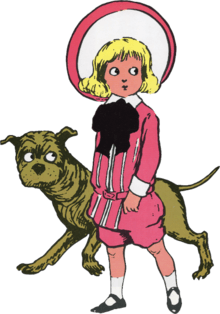Buster Brown suit

A Buster Brown suit was a very popular style of clothing for young boys in the United States in the early 20th century. It was named after the comic strip character Buster Brown, created in 1902 by Richard Felton Outcault.[1] It typically consisted of a belted, double-breasted tunic or jacket worn with a large round collar, floppy bow, and shorts or knickerbockers, and was often worn with a round straw hat and a haircut with bangs.[1][2] Along with the sailor suit, the Eton suit, the Norfolk suit and the Fauntleroy suit, the Buster Brown suit is cited as one of the key looks in boys' clothing of the period.[3][4]
The suit was typically chosen by mothers for their sons against their children's wishes.[5] It was perceived by mothers as a symbol of neatness and gentility but could lead to its wearer's being mocked by other children and called a "sissy".[6][7] Mark Rothko, who arrived in the States as a child immigrant with his family in 1913, was deliberately dressed in a Buster Brown suit made in Daugavpils in order to camouflage both the family's poverty and their Russian-Jewish origins.[8] The Buster Brown suit was also occasionally worn by older boys and men, such as the teenaged Eugene Bullard, a fan of the comic strip, who in the late 1900s purchased a Buster Brown suit with knickerbockers for Sunday best.[5]
References
- 1 2 Olian, edited by JoAnne (2003). Children's fashions, 1900-1950, as pictured in Sears catalogs. Mineola, N.Y.: Dover Publications. ISBN 9780486423258.
- ↑ O'Donnol, Shirley Miles (1989). American Costume 1915-1970: A Source Book for the Stage Costumer. Indiana University Press. p. 15. ISBN 9780253113733.
- ↑ Griffin, Irene Frances (1955). Children's Costume: Its Development and Stage Reproduction. Department of Speech and Drama, Stanford University. p. 183.
The three most important innovations in the last part of the century were: the sailor suit, the "Little Lord Fauntleroy" suit, and the "Buster Brown" suit.
- ↑ Stamper, Anita; Condra, Jill (2010). Clothing through American History the Civil War through the Gilded Age, 1861-1899. Santa Barbara: ABC-CLIO. p. 351. ISBN 9780313084584.
- 1 2 Lloyd, Craig (2000). Eugene Bullard, black expatriate in jazz-age Paris. Athens: University of Georgia Press. pp. 21–24. ISBN 9780820321929.
- ↑ Hirschhorn, Clive (1975). Gene Kelly : a biography. Chicago: Regnery. p. 27. ISBN 9780809282609.
From the age of seven Gene remembers being dressed in his neat Buster Brown suit and being taken to a dance school in downtown Pittsburgh by his determined mother. He remembers, too, the taunts and jeers of the rough neighbourhood boys, who would place their hands on their hips effeminately and call him a sissy
- ↑ Mercante, Arthur (2007). Inside the Ropes. McBooks Press. p. 13. ISBN 1590132947.
- ↑ Breslin, James E.B. (1998). Mark Rothko : a biography (Pbk. ed.). Chicago: University of Chicago Press. p. 22. ISBN 9780226074061.